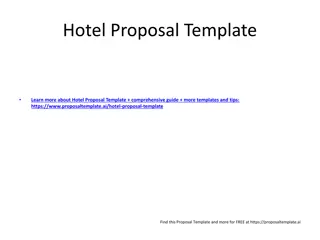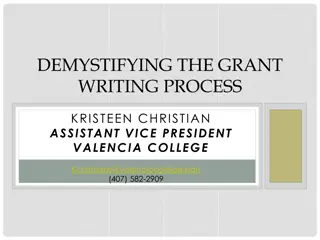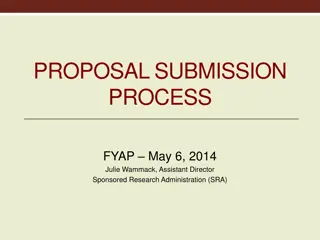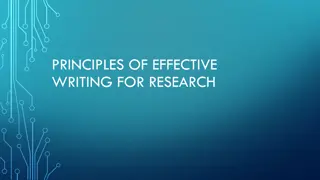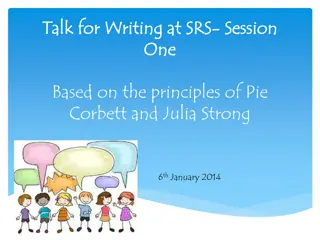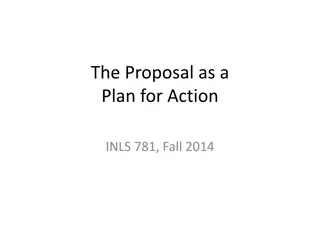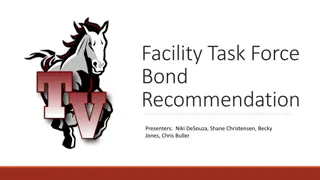Writing a Research Proposal: Components and Guidelines
Crafting a successful research proposal involves understanding the key components, structuring a compelling narrative, and addressing funders' needs effectively. Dive into the intricacies of grant proposals, from title formulation to budget planning and evaluation criteria, to enhance your proposal writing skills with practical insights and tips.
Download Presentation

Please find below an Image/Link to download the presentation.
The content on the website is provided AS IS for your information and personal use only. It may not be sold, licensed, or shared on other websites without obtaining consent from the author.If you encounter any issues during the download, it is possible that the publisher has removed the file from their server.
You are allowed to download the files provided on this website for personal or commercial use, subject to the condition that they are used lawfully. All files are the property of their respective owners.
The content on the website is provided AS IS for your information and personal use only. It may not be sold, licensed, or shared on other websites without obtaining consent from the author.
E N D
Presentation Transcript
PRESENTATION TO THE NORTH CAROLINA COUNCIL ON DEVELOPMENTAL DISABILITIES (NCCDD) ADVOCACY DEVELOPMENT AND COMMUNITY LIVING COMMITTEES AUGUST 6, 2020 THE ALLIANCE OF DISABILITY ADVOCATES A CENTER FOR INDEPENDENT LIVING
FIVE CORE SERVICES CILS ARE MANDATED TO PROVIDE (1) Information and referral services is provided to all individuals who contact ADANC in accessible formats : (2) Independent Living Skills Training (3) Peer Support (including cross-disability peer support) (4) Individual and Systems Advocacy (5) Transition Services: Youth, Transition from Institution and Diversion (keeping consumers out facility- based care)
TRANSITION FROM INSTITUTIONS TO COMMUNITY Institutional Transition ADANC provides services to individuals with disabilities to assist with transitioning from an institution such as a rehab hospital, nursing home, adult care home, or a correctional facility to a community setting. Staff work with a transitioning individual to identify their goals for independent living help provide the services and supports necessary to move from an institutionalized setting into the community. Institutional Diversion is when ADANC provides services and supports to those at risk of entering or returning to an institution, so they can stay in the community. The goal is to help the consumer identify at risk factors that might cause them to go into or return to an institution. Recently incarcerated individuals are at risk of returning to prison.
ALLIANCE OF DISABILITY ADVOCATES STATE REENTRY ADA Reentry is a program that supports and advocates for justice-involved persons with intellectual and developmental disabilities. Individuals elect to participate in the program and are motivated towards pro-social behavior through adaptable supports. Services are tailored to the participant s specific goals with the greater objective of integrating independently into their community. ADA works to remove stigma and increase positive awareness in our communities.
SUCCESSFUL REENTRY PROGRAMS Successful reentry programs work to fill the gap that exists between recently released inmates and sustainable success. For many incarcerated individuals, the first few hours and days after they leave prison or jail are critical. In many states, they are handed a few dollars and dropped off at the nearest bus or train station. Not only are they faced with the prospect of finding transportation and shelter with little or no resources, but the structure and experience of being in prison can exacerbate the lack of education, problem-solving skills, and resiliency that often led to their incarceration in the first place. Successful reentry programs provide support that is positive. This means rewards are greater and when there is success, no matter how small, the success is celebrated and rewarded, and individuals are more likely to reach their goals and milestones. Plus, when positive encouragement is paired motivational goal setting and role-playing, recidivism goes down. These types of techniques can be integrated into individual reentry plans. Successful reentry must focus on not just teaching folks how to succeed but helping them experience what success feels like.
WHY REENTRY IS VITAL Despite the occasional success story of a former inmate building a successful life, research continues to show that as many as 75% of ex-prisoners find themselves back in the criminal justice system within the first year. Successful performance management of re-entry programs and other anti-recidivism resources are critical to change those outcomes. And at the end of the day, reducing recidivism is important for both individuals and communities.
IMPORTANCE OF INITIALIZED REENTRY PLAN ADA implements the Independent Living philosophy with all the services that we offer. This is vital with reentry as well. Transitioning back into community life from any incarceration is challenging. This challenge increases in difficulty exponentially as the time of incarceration increases. It s not enough to simply offer blanket-style reentry resources to individuals pending release. This is the approach/mindset of the Correctional system. The typical ratio of Reentry Specialists to individuals being released who need reentry services on average is 45 to 1, sometimes more. The generic information given to these individuals is often outdated and is often not relevant to the needs/goals of the individual. Once an individual is released with no viable resources or positive supports, they are more likely to reoffend and return to prison.
INDIVIDUALIZED REENTRY PLANNING Development of the IRP (Individualized Reentry Plan) starts at our first meeting with the justice involved individual. The most important facet of the IRP is listening to the individual about what they think they need to be successful and not return to prison. Empowering individuals to make decisions about their IRP gives them a voice - something they lost as soon as incarceration began. Empowering individuals shows that ADA is invested in THEIR plan for success. There is no such thing as one size fits all. Programs and strategies built on this framework targets resources to those offenders who are at higher risk of recidivism and provides individualized services to address barriers that each consumer may be expecting.
RESOURCES INVOLVED WITH IRP We provide and connect individuals to: Housing Opportunities Employment Assistance Suitcessful and Food Pantry Benefits Counseling Independent Living Skills Training Travel Training Behavioral / Mental Health Resource information Peer Recovery Support Services and Mentoring
COLLABORATIONS Reentry and recidivism reduction are multifaceted issues, and no single program can address all the needs at every stage of the process. The range of challenges that lead to recidivism can include barriers to employment, lack of problem-solving skills, unresolved emotional and mental health conditions, substance abuse recovery, isolation and lack of community integration, and many others. Plus, ADA recognizes that successful reentry doesn t start the day someone is released from prison or jail. The best outcomes occur when there are preparation and support before, during, and after release. Collaborations and business relationships will be created and established to assist with the IRP. ADA already has open lines of communication with the Dunn Rotary Club Of NC.
EXPERTISE IN REENTRY ADA has been doing Reentry Transitional Services on a federal level at Butner FCI since 2016. Over 200 individuals in Butner have benefitted from ADA IRP services, with some justice involved individuals being released to the Triangle Area and continuing with their Reentry Services. Of all the individuals enrolled in the Reentry Program at Butner, only 2 have reoffended and returned. That is a 1% recidivism rate compared to the National Average of 77%. ADA also has unique staff with actual lived experience of being incarcerated for an extended amount of time and has first-hand knowledge of ADA Reentry program. Our first reentry consumer will be working on this grant.
CLOSING Whether focused on education, employment, transitional housing, substance abuse treatment or building cognitive and emotional resources, ADA knows individualized goals support successful reentry and reduce recidivism. Luckily, the increased awareness of evidence-based best practices can provide a strong foundation, and ADA believes we can succeed in creating safe communities that successfully integrate formerly incarcerated individuals.
3725 National Drive, Suite 105 Raleigh, NC 27612 Toll-Free: (877) 235-4210 Phone: (919) 591-0891 (D) Website: www.adanc.org Email: info@adanc.org



